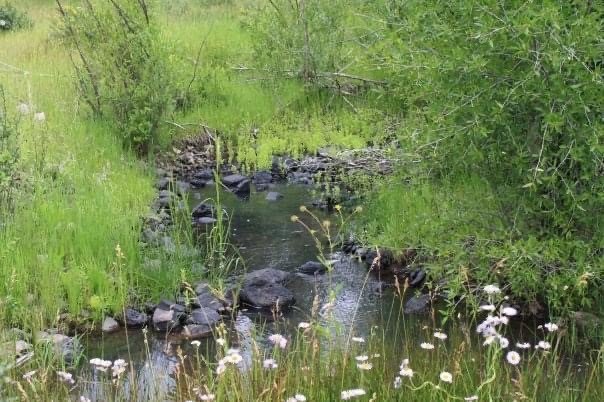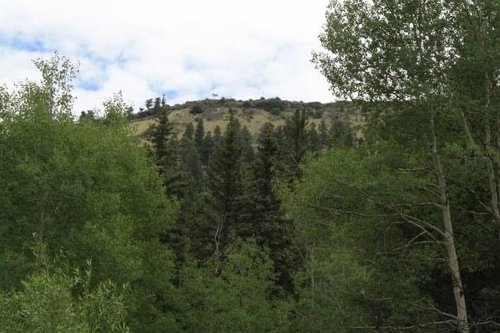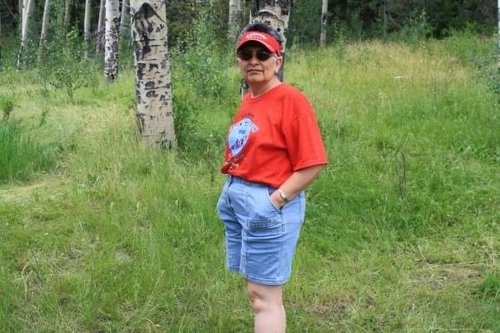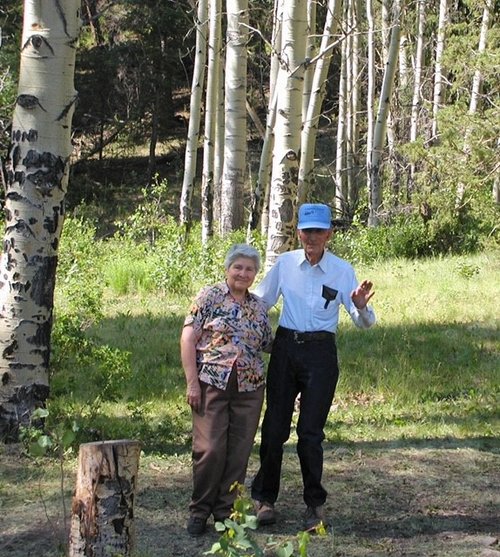By Linda Lidov, Keep it Colorado
Summertime at the Ruybal Fox Creek Ranch in the early 1960s was a living dream for Josie Ruybal Abeyta. Then just a young girl, Josie filled her days running around the mountainside, fishing, and watching the beavers do their busy work. “It was my favorite place on Earth,” says Josie, whose family has lived on and worked the land for four generations.
Josie has taken steps to ensure that the ranch stays special forever. Conserving it benefits her family and the wildlife that make their home here – and also sustains a much larger cultural and environmental landscape that defines southern Colorado.
NATURE'S PLAYGROUND
Fox Creek is a multi-faceted landscape close to Colorado's border with New Mexico. Situated in a dramatic canyon in the foothills of the South San Juan Mountains, Fox Creek is surrounded on three sides by the Rio Grande National Forest, Bureau of Land Management public lands and state lands. It’s also near the Conejos River, a fly-fishing paradise.
Fox Creek itself and the land along it provide for rich and diverse plant life. The hills, canyon cliffs and mesas are decorated with a cornucopia of flora, from the gnarled but picturesque pinyon pines to the cottonwoods and aspens, as well as native grasses, willows and wildflowers.
A wildlife wonderland, more than 40 species of animals roam here, from big game like elk, black bear and bobcat, to lesser-known creatures such as the western small-footed myotis and Townsend’s big-eared bat. Endangered species, including the Mexican spotted owl and the yellow-billed cuckoo, find refuge in this habitat. More than 68 bird species have been documented here.
For Josie, the place is special for the memories her family created in her growing-up years. Her father came from a large family, and on the 4th of July Josie’s uncle would dig a pit and cook a pig; tents and campers burst with cousins. Sometimes, her dad hosted his hunting buddies. One afternoon the priest even came to give Sunday Mass on the land. It was a welcoming place. “There were always tons of people coming to see us,” she says.
During those summer months, the family returned to its home in nearby Antonito only to buy groceries and go to church.

‘THEY’RE NOT MAKING ANY MORE LAND’
In 1962, Josie remembers lying in bed, hearing her father, Enos Ruybal, talk about what it would take to buy the 800-acre ranch. It was listed for $10 per acre. On Enos's salary as a school bus driver, $8,000 was a lot. “But he did it. He walked that land. He loved it,” she says.

When Enos died in 2005, he passed Fox Creek Ranch down to his six daughters. As can be with large families, the siblings had differing opinions about what to do with it. Given the region’s growing popularity and the property’s proximity to surrounding undeveloped public lands, it would be very attractive to developers. Downstream, private lands are already subdivided into 35- to 50-acre large-lot tracts. Subdividing and selling the 800 acres would be lucrative.
Some of Josie’s siblings wanted to sell. That did not appeal to Josie, who wanted to keep the land in pristine condition. “The whole thing together is beautiful. If you start taking it apart, it’s not. The whole makes it special.”
Josie stood fast in her goal to protect the landscape – honoring the land itself, the family’s legacy, and the legacy of the families who came before hers. “There were families who came over before the U.S. was the U.S. Our ancestors came here. Hispanic families had large pieces of property that got sold off. But those who do still have large properties can leave something behind that says, ‘We value the land, we work the land, we want it to stay.’”
She stalled her siblings. In the meantime, she researched conservation easements – voluntary legal agreements to protect land in perpetuity. She saw a win-win: Those who preferred money would benefit from the sale of the easement and state tax credit incentives, and the family would still be able to use and enjoy the land.
“You can always use money, but you will never have the land again. They’re not making any more land. We need to do what we can to protect it."

She began by applying for a conservation easement through a government agency. But her application was rejected. Every year for five years she re-applied, strengthening her application each time to demonstrate the land’s conservation values, even consulting with a biologist to properly note the names of the bugs, birds and flora.
“The fifth time I applied, I was told to face the fact that I couldn’t ‘play ball.’ I was told I would never have this. I was ready to give up."
Then someone suggested she call Congressman Donald Valdez, a state representative in southern Colorado. Valdez worked at the Natural Resources Conservation Service and understood the conservation values of this land. He had visited Fox Creek with Josie and recognized a particular feature that could lead to protection opportunities: a working spring.
THE RUYBAL OJITO SPRING
Several springs used to run through the Fox Creek Ranch property. Most have dried out, but one is still producing: the Ruybal Ojito Spring. Since 1962 it has consistently pumped a gallon of water per minute. Unfortunately, cows from nearby properties, as well as deer and antelope, were destroying the ojito (Spanish for spring) and the land around it.
Josie was able to get some restoration help, including fencing off the ojito and laying pipes underground to syphon water away to a stock tank. Valdez built the spring box. But there is still work to do, including replacing the fallen fence her dad and brother installed in the 1960s on the property’s perimeter.
A conservation easement would protect the spring and the land in perpetuity. But Josie still wondered, "How do I get an easement?"
Valdez recommended that she contact the Rio Grande Headwaters Land Trust (RiGHT). When she called RiGHT, she was urged to speak with other landowners who had put easements on their land. After hearing from two others about their experiences, she decided to move ahead with RiGHT's help.
"This keeps the place the way my dad saw it,” she says, adding, “We named the easement after him. I can’t think of Fox Creek without thinking about my dad.”
A FUTURE VISION
The easement is scheduled to close in summer 2022. But the work to protect the property won’t stop

there. Josie plans to finish rebuilding the fence to keep cows out while allowing pronghorn deer to safely get through and move freely across the lands. She would also like to re-introduce beavers, which have disappeared over the years. And she wants her family to continue coming to the land to enjoy it.
After that, time will tell. But Josie will rest assured knowing that the land will be protected in perpetuity.
“When I die, the land will stay the way it is whether my family owns it or not. That’s my vision.”
SERVING AN OFTEN-OVERLOOKED COMMUNITY

There are many exciting aspects to conserving Fox Creek Ranch, according to Joelle Marier, associate director for RiGHT. One is its location.
“It’s the last piece of private property along Fox Creek before the creek is in public land. That helps preserve the water source and its quality, and enhances the connectivity across those lands for wildlife,” Joelle says.
But for Joelle, this project is especially exciting for its cultural and historical significance in a community that often gets overlooked in the conservation arena.
In the larger San Luis Valley, where Conejos County is located, more than 50 percent of the population is Hispanic. As RiGHT expands its work, it aims to make conservation opportunities and new types of conservation projects available to more local landowners and partners.
"Now we have the flexibility to start reaching larger San Luis Valley communities, with a focus on local family farms and ranches, and preserving the cultural legacy that makes these places special," Joelle says. That starts with building more relationships and trust with landowners who are passionate about protecting these landscapes.
Speaking of Josie Abeyta and her family, Joelle adds, “Conservation preserves this family’s legacy. They have major family ties to the land, and their culture is built on it.
By protecting places like Fox Creek, we boost the overall scale and scope of conserved land. And the cultural heritage of Conejos County – and the entire southwest region – can endure on a landscape scale.”
The Fox Creek easement process is being aided by a grant from Keep It Colorado. The grant will help Josie and her sisters cover the costs associated with the transaction – such as the appraisal, the baseline documentation and surveys. Additionally, Natural Resources Conservation Service funded RiGHT's purchase of the easement, and the Sangre de Cristo Natural Heritage Area provided funding. Rio Grande Headwaters Land Trust will hold the easement and monitor it annually to ensure that the integrity and the terms of the easement are upheld in perpetuity.
